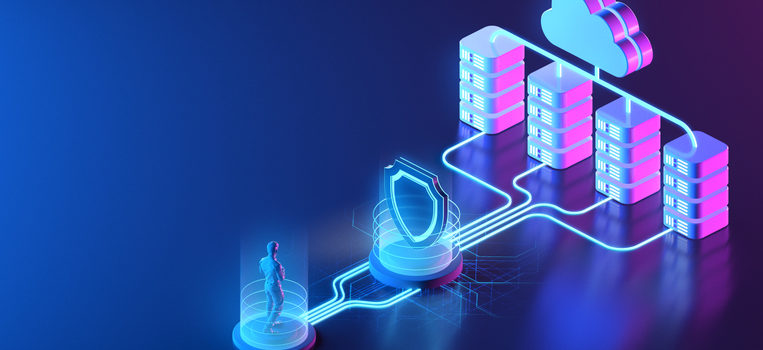For businesses weighing the pros and cons of migrating applications and data to the cloud, there are often questions about using the cloud. One of the most critical is how the cloud stacks up on security. It’s natural to wonder, is using the cloud safe?
For first-time cloud users, there can be a hesitation to convert unless they have a solid understanding of how the cloud works and its security integrity. To answer this, we’ve put together some key facts and information.
How Does the Cloud Work?
To begin, let’s start with some basics. The cloud is a virtual space that lives online. If something is in the cloud, it’s not on your physical device. You access applications, documents, and data from the cloud by having an internet connection and logging into the platform. Many service providers offer cloud storage to individuals and businesses. The most prominent players include Google, Amazon Web Services (AWS), and Microsoft Azure.
Is Everybody Using the Cloud?
The majority of companies (90 percent) use the cloud for at least some applications. That’s a pre-pandemic stat. COVID-19 forced many organizations to migrate to the cloud to enable remote work. A survey from mid-2020 revealed that 87 percent of enterprises will accelerate cloud migration as a direct result of the pandemic. That adoption is reducing on-premises workloads, with companies moving to public, private, and hybrid models.
With such aggressive movement toward the cloud, the logical conclusion is that it adds significant value. This can be in the form of reduced costs, greater flexibility, improved accessibility, and more streamlined processes.
A McAfee report found that 87 percent of companies that use cloud services experience business acceleration. Balancing the value cloud usage drives with security is still a major concern. So, how does the cloud keep applications, data, and infrastructure safe?
Cloud vs. On-Premises Security
In operating a business, either you use technology in the cloud or on-premises. Which is more secure? The cloud makes a strong case for its security.
The big cloud service providers are using the most advanced cybersecurity, and they are responsible for updates. You still have some responsibilities, but it’s less of an internal burden. Whereas, for on-premises, it’s all on you and your team.
Cloud security has a centralized core, so it’s much easier to monitor the network. On-premises is more complicated and harder to manage.
Security incidents are possible in either model. However, most cloud-based security failures fall on the shoulders of end-users. These can relate to errors in configurations or employees that breach a password or fall for a phishing scam.
Third parties are security experts, and their protocols scale across all your cloud apps and are in force no matter where users are. That same level of scrutiny and detail is often unachievable for internal IT teams.
Who “Owns” Cloud Security?
In looking at the cloud vs. on-premises, the scales are tipping toward the former. However, it’s a normal reaction to feel like something is less safe if you don’t control it. How much control depends on the model you use:
- SaaS (Software as a Service): Vendors update software.
- IaaS (Infrastructure as a Service): You configure the cloud.
- PaaS (Platform as a Service): Coding is necessary.
Most new cloud users and SMBs choose SaaS since it’s easier to deploy and manage. Next, we’ll talk about how third parties ensure security.
How Do Cloud Storage Providers and SaaS Companies Ensure Security?
In determining if the cloud is safe to use, you’ll want to know how cloud storage providers and SaaS companies keep it secure. While you do have some control over security on the end-user side, they build the infrastructure and controls.
Firewalls
Firewalls are a standard line of defense. The simplest only examine the source and destination data. Cloud firewalls are more advanced, verifying everything. Additionally, internal firewalls keep out accounts that shouldn’t have access to certain data. Limiting access to only those that need it can bolster security, as well.
Intrusion Detection
Another defense is using technology to identify if an unauthorized user is attempting to intrude and break into the system. This is a multi-layered approach that stops intruders if they make it through the initial defenses.
Event Logging
With event logs, security professionals can better understand new and emerging threats. They record network activity. The analysis of this data enables better positioning to predict and prevent attacks.
Encryption
When data is moving or at rest, much of the time encryption is necessary. That’s especially true for regulated industries like healthcare. In the case of a penetration or data breach, hackers may steal files, but if they are encrypted, they are worthless because they don’t hold the key.
Physical Security
Even though the cloud is virtual, there are real servers in data warehouses. The top providers and SaaS companies use highly secure facilities. They have 24/7 monitoring, stringent access protocols, and guards. They are much more secure than an on-premises server room.
While providers deliver these assurances, cloud users have responsibilities, too. Areas where you can enhance security include:
- Strong password controls and use of two-factor authentication
- Educating employees on cybersecurity risks
- Creating incident response plans should a breach occur
Want to Learn More About the Cloud?
Moving to the cloud is a big decision, but you can have peace of mind on security by being aware and informed. Learn more by reading our post on everything you need to know about the cloud.
May 27, 2021
Explore other posts on these topics:
